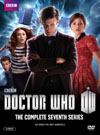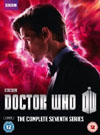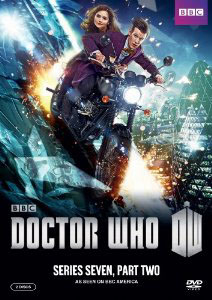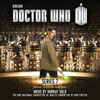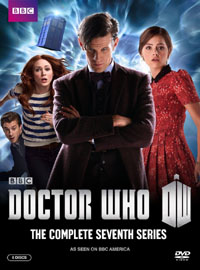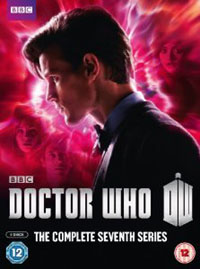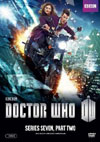DVD Extras for this story on the 15-episode box sets include:
This adventure works as a piece of the ongoing story of Season 33, inheriting momentum from "The Snowmen" (the previous story) and propelling the viewer into the following stories with more, but somehow it only feels like a fun, necessary pit stop on the road to greater things.
Media MetaphorThe primary sci-fi idea of the piece is all centered on internet use. In terms of its realistic credibility, it is on quite shaky ground. Borrowing jargon and graphics for uploading and downloading suggests that some form of copying would be taking place... which would naturally steer the drama towards the concept of identity theft as we saw in "The Almost People" (story no. 222). What Moffat really wants here is just one unique version of every person, with a struggle over his or her location and individual integrity.The execution of the idea directorially is problematic as well when it comes to the spoonhead robots needed to complete this sci-fi process. They really become quite obvious by moving so slowly and suspiciously - suggesting that a very small percentage of their intended victims would actually get scooped up properly, while smashed robots, media attention with pictures, and organized responses from U.N.I.T. become more common. The premise also gets muddled over the number of people caught up in this, and how deeply. Later sections want to suggest a near-total Matrix-like control over anyone and everyone, which never really gets set-up believably at any point. Ultimately, the internet idea works best on the level of being a metaphor. Marshall McLuhan's book on Understanding Media: The Extensions of Man very cleverly points out how many of our technological advancements in creating new media, including such things as basic as the alphabet, industrial career specialization, and evolving forms of physical transport, all managed to change the way humans functioned in the world, how we viewed it, how we viewed ourselves and our personal boundaries. Each technology altered the speed and ease and style with which we could communicate with each other and our environment, sometimes radically, and the types of things we believed were important and entertaining and paid attention to evolved. Many of McLuhan's predictions about television turned out to be more true for the personal computer and the internet - a difference he did not predict in 1964. But the basic premise is that humanity's very nervous system extends electrically through a technology like the internet, and when use of this becomes the day-to-day norm for a person, other more basic aspects of our lives like our physical presence atrophy and become less used, less important, less skilled. How often do we come across people in public who are so absorbed in whatever they are doing with their portable devices that they seem to have no clue where they physically are or what is physically happening around them? Steven Moffat's story here plucks a nice archetypal thread with that theme, and plays up the fear factor a bit while running with it. A worthwhile exercise. And on the whole, this metaphor is better fleshed out and better used than similar ideas about television back in "The Idiot's Lantern" (story no. 177). Additionally, one wonders if some of the abilities Oswald displayed back in "Asylum of the Daleks" (story no. 231) are completely explained by what happens to her here, or merely being hinted at? Stay tuned to find out more.
Partnership CharmIn a lot of ways though, the internet plot is just a typical adventuresome Doctor Who backdrop for the central focus of the story: The Doctor and the real Clara's "first date". Internet metaphors for their relationship are at work here again, in the sense that the Doctor's already been chatting with her avatars in "Asylum of the Daleks" and "The Snowmen", with "The Snowmen" metaphorically containing the first photo of her that he sees. The Doctor also feels that he has already got to know her, but like so many people starting out in any relationship (but especially internet ones), he has allowed himself to fill in too many of the blanks with characteristics from those alternate/fantasy versions of her (as people often do when they let their imagination run away too freely), and he sabotages his early attempts at good relations by not being on the same page as her, open to who she might uniquely be face to face.Of course, there are many more metaphors that can be read into this tale, including the sequence of the Doctor trying to convince Clara to enter what she calls his "snog-box", followed by the whirlwind airplane sequence that eventually turns her world upside-down, which then fast-forwards into "the morning after". Only Moffat knows at this stage how much of this script was intended as relationship metaphor, or whether or not it tops "The Empty Child" (story no. 168, also by Moffat) in the sheer number of metaphoric references. Thankfully, the episode remains fun and entertaining enough while focusing on these two. Smith and Coleman work well off of each other. They are compelling and hold the show together, infusing it with an infectious dose of the fun factor. Good stuff.
Business As UnusualThe visible antagonistic forces of the tale have a cool concept to work with and employ some clever stratagems not seen before on this show, but for the most part they are simply cookie-cutter corporate placeholders, and as such not all that interesting. Celia Imrie does alright with the major adversarial role of Miss Kizlet, thankfully avoiding the head-bobbing stereotype, but remains of limited interest. The real question of course is, who is "The Client" that they work for?The reveal of the Great Intelligence is very good, with a few lines from a ghostly visual of Richard E. Grant helping to seal the recognition factor and indicate this villain's path of growth. We can assume that the Intelligence spawned in "The Snowmen" has continued to grow side by side with humanity during "The Abominable Snowmen" (story no. 38) and "The Web of Fear" (story no. 41), and now that it has reached the age of information, it has naturally found expression in digital form. Thus its place in Doctor Who chronology is working excellently, and this tale gets a huge boost in audience interest with this last minute reveal. But in this story, we've really only just been teased - "The Snowmen" was a more satisfying struggle with the Great Intelligence. Anticipation for yet another adventure with the Doctor vs. the Intelligence is firmly planted here, but will the next encounter deliver? This was a good lightweight encounter, but really leaves us wanting something bigger and more substantial.....
International Titles:Deutsch: "Die Glocken von Saint John"Magyar: "Szent János harangjai"Français: "Enfermés dans la toile"Русский: "Колокола Святого Иоанна"Italiano: "Le campane di St. John"It is curious to see which languages decided to translate the name "John", and which left it in its original English. Meanwhile, the French cut through to a more obvious layer of this story, calling it "Locked in the Web".
This story has become available on DVD and Blu-ray.
This story is also available in an 8-episode volume with minimal extra features. The U.K. version also includes the episode "The Snowmen"; North American versions do not. Click on the Amazon symbol for the location nearest you for pricing and availability:
Comments on this article are welcome. You may contact the author from this page:
|
|||||||||||||||||||||||||||||||||||||||||||||||||||||||||||
